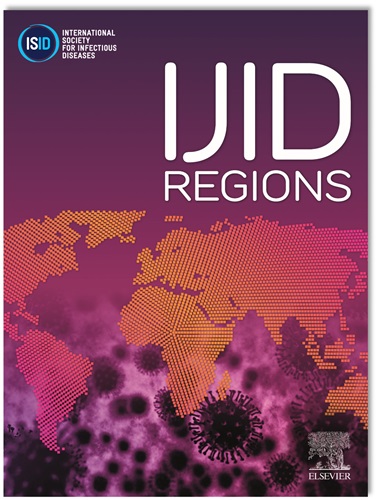艾滋病毒-1传播集群和男男性行为者传播耐药性的决定因素:葡萄牙的一项多中心研究(2014-2019)
IF 4.8
2区 医学
Q1 INFECTIOUS DISEASES
引用次数: 0
摘要
简介:在欧盟/欧洲经济区,男男性行为者是预防和控制HIV-1感染的优先群体。在葡萄牙,2023年艾滋病毒发病率为每10万居民8.2例,新感染876例,其中41.7%为男男性行为者。我们的目标是表征2014年至2019年间葡萄牙新诊断的MSM中HIV-1传播簇(TC)和传播耐药性(TDR)及其社会人口学,行为,临床和病毒基因组决定因素。方法:选取葡萄牙17家医院340例新诊断为HIV-1感染的男男性行为者。分枝支持度≥90%,遗传距离为1.5%。采用Logistic回归模型检验与TC和TDR相关的因素。结果:我们鉴定出38个TC和104个MSM,其中包括我们样本中纳入聚类分析的305个MSM中的81个(26.6%)。TDR的总患病率为8.2%。只有HIV-1亚型C与TDR显著相关。10.5%的聚集性感染至少存在1个监测耐药突变(SDRM)。在TDR患病率或葡萄牙人和移民男同性恋者在群集内外的比例上没有显著差异。诊断年龄、居住地区、无保护的性行为、HIV检测、呈现者状态和HIV-1亚型与TC显著相关。结论:MSM的特定亚群是葡萄牙HIV-1聚集性传播的原因。然而,没有发现TDR与社会人口学或行为因素之间的关联。有针对性的预防措施应侧重于这些亚群体。本文章由计算机程序翻译,如有差异,请以英文原文为准。
Determinants of HIV-1 transmission clusters and transmitted drug resistance in men who have sex with men: A multicenter study in Portugal (2014-2019)
Introduction
In the EU/EEA, men who have sex with men (MSM) is a priority group for the prevention and control of HIV-1 infection. In Portugal, the 2023 HIV incidence rate was 8.2 per 100,000 inhabitants, with 876 new infections, 41.7% in MSM. We aim to characterize HIV-1 transmission clusters (TC) and transmitted drug resistance (TDR) and its sociodemographic, behavioral, clinical, and viral genomic determinants in MSM newly diagnosed in Portugal between 2014 and 2019.
Methods
A total of 340 MSM newly diagnosed with HIV-1 infection at 17 hospitals in Portugal were included. TC was identified with branch support ≥90% and 1.5% genetic distance. Logistic regression models were used to examine factors associated with TC and TDR.
Results
We identified 38 TC with 104 MSM, which includes 81 (26.6%) of the 305 MSM from our sample included in cluster analysis. The overall prevalence of TDR was 8.2%. Only HIV-1 subtype C was significantly associated with TDR. Overall, 10.5% of the clusters had at least 1 surveillance drug resistance mutation. There was no significant difference in the prevalence of TDR or the proportion of Portuguese and migrant MSM inside and outside clusters. Age at diagnosis, district of residence, unprotected sex with a woman, HIV testing, presenter status, and HIV-1 subtype were significantly associated with TC.
Conclusion
Specific subgroups of MSM are contributing to HIV-1 clustered transmission in Portugal. However, no association was found between TDR and sociodemographic or behavioral factors. Directed prevention measures should focus on those subgroups.
求助全文
通过发布文献求助,成功后即可免费获取论文全文。
去求助
来源期刊
CiteScore
18.90
自引率
2.40%
发文量
1020
审稿时长
30 days
期刊介绍:
International Journal of Infectious Diseases (IJID)
Publisher: International Society for Infectious Diseases
Publication Frequency: Monthly
Type: Peer-reviewed, Open Access
Scope:
Publishes original clinical and laboratory-based research.
Reports clinical trials, reviews, and some case reports.
Focuses on epidemiology, clinical diagnosis, treatment, and control of infectious diseases.
Emphasizes diseases common in under-resourced countries.

 求助内容:
求助内容: 应助结果提醒方式:
应助结果提醒方式:


